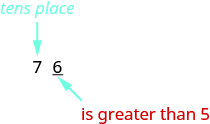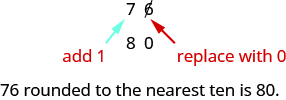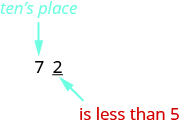1.16: Rounding Whole Numbers
- Page ID
- 45754
Learning Objectives
- Round whole numbers to a determined place value

The electronics retailer, Best Buy, had brick and mortar stores open in October of
. Depending on how this information will be used, it might be enough to say that the company has approximately one thousand stores. The word approximatelymeans that one thousand is not the exact count, but is close to the exact value.
In , the social network app, Facebook, reported its annual revenue as
billion US dollars. This could mean they actually brought in
or
. Sometimes the detail is needed, but sometimes just an approximate value is good enough. The real estate app, Zillow, recorded a profit of
billion US dollars; this is an approximate value. If you want to compare Facebook’s
revenue with Zillow’s
revenue, the precise dollars or even millions of dollars are unnecessary.
The process of approximating a number is called rounding. Numbers are rounded to a specific place value depending on how much accuracy is needed. Identifying the number of stores owned by Best Buy as approximately thousand means we rounded to the thousands place. Reporting the annual revenue of Facebook as
billion US dollars means we rounded to the hundred millions place. Often the place value to which we round depends on how we will need to use the number.
Using a number line can help us visualize and understand the rounding process. Look at the number line below.
Suppose we want to round the number to the nearest ten. Is
closer to
(
tens) or
(
tens) on the number line?
We can see that is closer to
than to
. So
rounded to the nearest ten is
.
Now consider the number . Find
on the number line.
We can see that is closer to
, so
rounded to the nearest ten is
.
How do we round to the nearest ten?
Find on the number line.
The number is exactly midway between
and
.
So that everyone rounds the same way in cases like this, mathematicians have agreed to round up to the higher number. So, rounded to the nearest ten is
.
Now that we have looked at this process on the number line, we can introduce a more general procedure. To round a number to a specific place, look at the number to the right of that place. If the number is less than , round down. If it is greater than or equal to
, round up.
So, for example, to round to the nearest ten, we look at the digit in the ones place.

The digit in the ones place is a . Because
is greater than or equal to
, we increase the digit in the tens place by one. So the
in the tens place becomes an
. Now, replace any digits to the right of the
with zeros. So,
rounds to
.

Let’s look again at rounding to the nearest
. Again, we look to the ones place.

The digit in the ones place is . Because
is less than
, we keep the digit in the tens place the same and replace the digits to the right of it with zero. So
rounded to the nearest ten is
.

Round a whole number to a specific place value
- Locate the given place value. All digits to the left of that place value do not change.
- Underline the digit to the right of the given place value.
- Determine if this digit is greater than or equal to
.
- Yes—add
to the digit in the given place value.
- No—do not change the digit in the given place value.
- Yes—add
- Replace all digits to the right of the given place value with zeros.
example
Round to the nearest ten.
Solution
| Locate the tens place. |  |
| Underline the digit to the right of the tens place. |  |
| Since |  |
| Replace all digits to the right of the tens place with zeros. |  |
| Rounding |
try it
[ohm_question hide_question_numbers=1]147151[/ohm_question]
Example
Round each number to the nearest hundred:
[reveal-answer q=”210558″]Show Answer[/reveal-answer]
[hidden-answer a=”210558″]
| 1. | |
| Locate the hundreds place. |  |
| The digit of the right of the hundreds place is |  |
| Since |  So 23,658 rounded to the nearest hundred is 23,700. |
| 2. | |
| Locate the hundreds place. |  |
| Underline the digit to the right of the hundreds place. | |
| The digit to the right of the hundreds place is |  So 3,978 rounded to the nearest hundred is 4,000. |
[/hidden-answer]
try it
[ohm_question hide_question_numbers=1]147152[/ohm_question]
example
Round each number to the nearest thousand:
[reveal-answer q=”935310″]Show Answer[/reveal-answer]
[hidden-answer a=”935310″]
| 1. | |
| Locate the thousands place. Underline the digit to the right of the thousands place. |  |
| The digit to the right of the thousands place is |  |
| We then replace all digits to the right of the thousands pace with zeros. |  So 147,032 rounded to the nearest thousand is 147,000. |
| 2. | |
| Locate the thousands place. |  |
| Underline the digit to the right of the thousands place. |  |
| The digit to the right of the thousands place is |  So 29,504 rounded to the nearest thousand is 30,000. |
Notice that in part 2, when we add thousand to the
thousands, the total is
thousands. We regroup this as
ten thousand and
thousands. We add the
ten thousand to the
ten thousands and put a
in the thousands place.
[/hidden-answer]
try it
[ohm_question hide_question_numbers=1]143029[/ohm_question]
TRY IT
[ohm_question hide_question_numbers=1]143030[/ohm_question]
Watch the video below for more examples of how to round whole numbers to a given place value.
- Question ID: 143029, 143030. Authored by: Alyson Day. License: CC BY: Attribution. License Terms: IMathAS Community License CC-BY + GPL
- Prealgebra. Provided by: OpenStax. License: CC BY: Attribution. License Terms: Download for free at http://cnx.org/contents/caa57dab-41c...cda5519c@9.757
- Ex: Rounding to the Various Place Values - Number Line / Formal Rules . Authored by: James Sousa (Mathispower4u.com). Located at: https://youtu.be/tpFCYyTi1hc. License: CC BY: Attribution
- Authored by: Ian Muttoo. Located at: https://www.flickr.com/photos/imuttoo/1435471427. License: CC BY-SA: Attribution-ShareAlike

